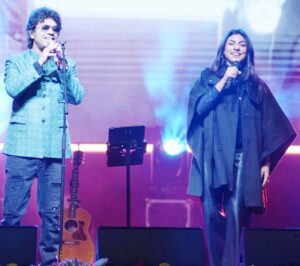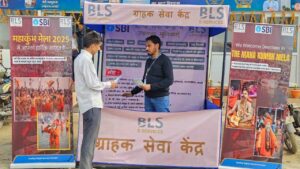All Living Things Environmental Film Festival 2024: 72 Films, 5 Continents, One Mission—Climate Awareness”

Mumbai : All Living Things Environmental Film Festival – India’s largest environment cinema based festival started in 2020 with the focus on using cinema as a medium to engage in a conversation around pertinent subjects of nature, environment and climate change. The festival now in its 5th year has roped in a great jury including actress and activist, Dia Mirza helming the jury and director Richie Mehta being roped in as an ambassador of the festival. This year the festival is set to take place from 22nd November to 8th December and has 72 films being screened this year as a part of it.
The screenings this time are truly set to reach places including rural India and in places where a conversation is imperative on the environment including Singla in Rajasthan, Brahmapur in Odisha, Andaman islands and Srinagar. The festival is going international this year with screenings set to take place in Costa Rica, Nepal, USA and Australia
This year’s edition of ALT EFF also has films across International Feature Films, International Short Films, Environmental Journalism, Indian Feature Films, Indian Short Films, Student Films and Animated Films. The selections for each of these programs exemplify the tenacity, commitment and hope of the creative community, as the climate emergency looms over us.
Some of the most interesting films this year include the following:
1-Some Thoughts on the Common Toad – by Oscar and BAFTA winning actress, Tilda Swinton
Some Thoughts on the Common Toad is a compelling cine-collage manifesto that defends the essence of beauty in an age marked by political cynicism and environmental alienation. Drawing inspiration from George Orwell’s thought-provoking essay, the film features a poignant narration by Tilda Swinton, whose voice brings a profound depth to the visuals. Through a rich tapestry of images and sound, Svatek explores the significance of the common toad as a symbol of natural beauty and ecological importance.
2- Wild Summon – Oscar Nominated in 2023 for Best Animated Short by Marianne Faithfull
Wild Summon is a natural history fantasy that chronicles the dramatic life cycle of wild salmon, portrayed in human form. Through mesmerising imagery and a narrative voice by Marianne Faithfull, the film immerses viewers in the salmon’s epic journey from freshwater birth to oceanic adulthood and back to their origins. This BFI short film intertwines myth and nature, exploring the profound connection between these remarkable creatures and their environment. The film’s rich visual storytelling and evocative narration offer a unique perspective on the wild salmon’s timeless odyssey
3- Jamna – The River Story
Jamna – The River Story takes an in-depth look at the critical state of Delhi’s Yamuna River, a once-pure waterway now facing severe ecological collapse. This 38-minute documentary explores the historical neglect and current mismanagement that have contributed to the river’s decline. Through interviews with experts and personal testimonies, the film uncovers the systemic indifference of authorities and questions public apathy towards this environmental crisis. Narrated by Shyam, a local boatman whose life is intertwined with the river, the film highlights the Yamuna’s deep cultural significance and the devastating impact of its degradation. The documentary is propelled by the unprecedented floods of 2023, which serve as a stark wake-up call. It emphasises the urgent need for action to protect and restore the Yamuna, stressing its importance for ecological balance, cultural heritage, and economic stability.
4- Foragers – A film by an influential Palestinian Visual Artist
Foragers depict the dramas around the practice of foraging for wild edible plants in Palestine/Israel with wry humour and a meditative pace. Shot in the Golan Heights, the Galilee and Jerusalem, it employs fiction, documentary and archival footage to portray the impact of Israeli nature protection laws on these customs. The restrictions prohibit the collection of the artichoke-like ’akkoub and za’atar (thyme), and have resulted in fines and trials for hundreds caught collecting these native plants. For Palestinians, these laws constitute an ecological veil for legislation that further alienates them from their land while Israeli state representatives insist on their scientific expertise and duty to protect. Following the plants from the wild to the kitchen, from the chases between the foragers and the nature patrol, to courtroom defences, Foragers captures the joy and knowledge embodied in these traditions alongside their resilience to the prohibitive law. By reframing the terms and constraints of preservation, the film raises questions around the politics of extinction, namely who determines what is made extinct and what gets to live on.
5- Sanctuary – A film by Min-Cheol Wang, South Korea
In Sanctuary, directed by Min-cheol Wang, the film delves into the ethical and emotional challenges faced by those committed to animal welfare in South Korea. The story revolves around Jeong-ho Kim, the dedicated head veterinarian of Cheongju Zoo, who dreams of transforming the zoo into the nation’s first true sanctuary, where animals can live in environments that closely resemble their natural habitats.
Jeong-ho’s vision is given a new sense of urgency when Tae-kyu Choi, a passionate animal welfare activist, is hired by the zoo. Tae-kyu’s main focus is on establishing a sanctuary specifically for farm bears that have been rescued from abusive conditions. These bears, having spent their lives in small, confined cages, are in desperate need of rehabilitation and a place where they can live out their days with dignity.
However, the journey toward creating this sanctuary is fraught with challenges. The nearby Chungnam Wildlife Rescue Center, which supports the idea of a sanctuary, faces its own struggles. The center’s employees, who are committed to the welfare of the animals they rescue, are often forced to make heartbreaking decisions to euthanize animals that cannot be released back into the wild. This painful reality underscores the necessity and urgency of establishing sanctuaries like the one Jeong-ho and Tae-kyu envision.
6-Gutter Ki Machhli ( Fish from the Sewer)
Gutter Ki Machhli (Fish from the Sewer) is an animated film that sheds light on the climate change struggles of residents in Govandi, a marginalised resettlement colony in Mumbai. Urban poor communities, like those in Govandi, face heightened vulnerability due to poor infrastructure and limited access to essential resources. The film highlights how inadequate living conditions lead to health issues and social stigma, exemplified by Ajaz, a youth denied health insurance due to high tuberculosis rates.
Produced as part of the Arts4Resilience “Knowledge into Use” Awards 2023 by Global Resilience Partnership, the film uses drawings and poetry created by local children, youth, and women to vividly depict their experiences of climate change. Through arts-based workshops, residents articulated their environmental challenges, providing a non-technical, empathetic view of their daily struggles. This approach not only builds evidence but also fosters a more inclusive discourse around environmental and climate issues. The film aims to create a local vocabulary for discussing these crises, making their impacts visible and relatable.
7- Plastic People – by Ben Addelman
Plastic People is a groundbreaking documentary that delves into humanity’s addiction to plastic and the alarming rise of microplastics, which pose a growing threat to our health. Directed by Ben Addelman and featuring acclaimed author and science journalist Ziya Tong, the film sheds light on the omnipresence of plastic in our environment and bodies. Almost every piece of plastic ever produced breaks down into microplastics—tiny particles that drift through the air, contaminate water sources, and seep into the soil, becoming a permanent part of our ecosystem.
The documentary takes a personal approach as Tong visits leading scientists worldwide to uncover the disturbing truth: microplastics are now found in human organs, blood, brain tissue, and even the placentas of new mothers. Through a series of revealing experiments conducted on her food, in her home, and on her own body, Tong investigates the potential health impacts of these invisible invaders.
Plastic People is more than an exposé; it’s a call to action. The film urges viewers to rethink their relationship with plastic and consider the long-term consequences of its pervasive use. With its powerful narrative and urgent message, Plastic People challenges us to confront the reality of plastic pollution and seek sustainable solutions before it’s too late.






